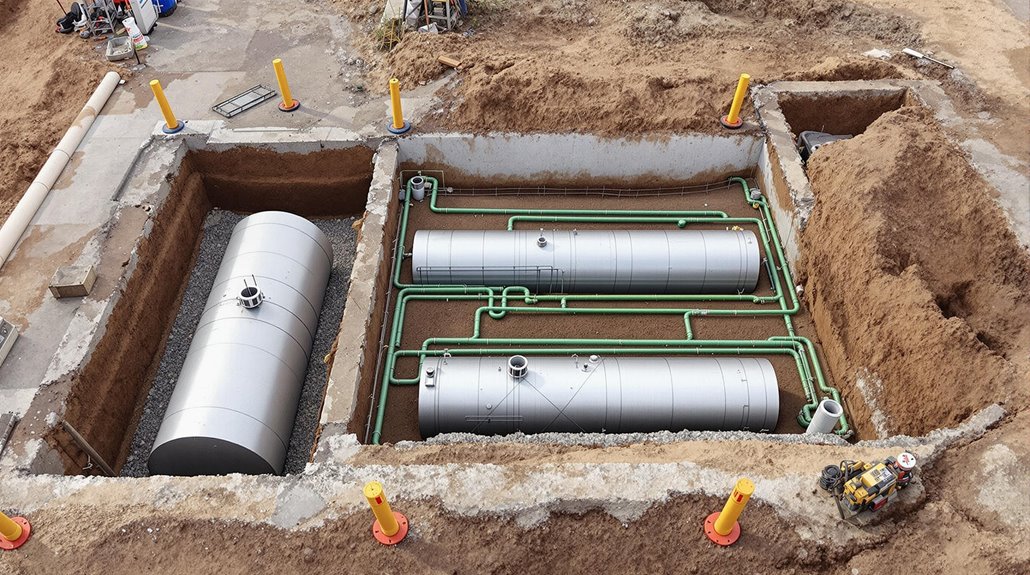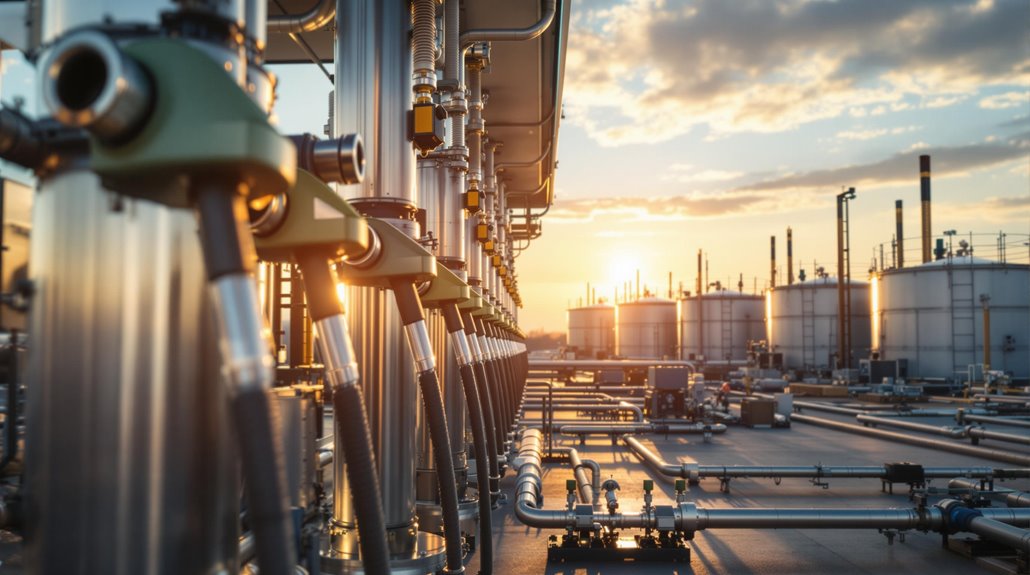Commercial petroleum equipment includes all the essential systems you’ll need to safely store and dispense fuel at gas stations or industrial facilities. You’ll find underground storage tanks, fuel dispensers with point-of-sale systems, and sophisticated monitoring devices that detect leaks and track inventory. Modern installations also require vapor recovery equipment, emergency shut-off systems, and environmental compliance technologies. Understanding these components is vital for running a successful fueling operation.
Types of Underground Storage Tank Systems

Underground storage tank (UST) systems come in several configurations to safely contain and monitor petroleum products beneath the surface.
You’ll find three main types that meet strict installation standards: single-wall steel tanks, double-wall fiberglass tanks, and composite tanks that combine steel and fiberglass materials.
Each system requires specific components to maintain regulatory compliance:
- Primary containment tank
- Secondary containment (for double-wall systems)
- Leak detection sensors
- Fill pipes and vent lines
- Spill prevention devices
- Overfill protection equipment
When you’re selecting a UST system, you’ll need to take into account factors like soil conditions, groundwater levels, and local regulations.
Double-wall systems offer enhanced protection and are becoming the industry standard, while single-wall tanks are being phased out in many regions.
Fuel Dispensers and Point-of-Sale Equipment
While underground storage systems form the foundation of a fuel station, the equipment customers directly interact with plays an equally important role.
You’ll find modern fuel dispensers equipped with user-friendly screens, multiple payment options, and sophisticated electronics that guarantee accurate fuel delivery and maintain fuel quality.
Today’s point-of-sale systems do more than just process payments – they’re integrated computers that help enhance the customer experience.
You can track inventory, monitor fuel sales, generate reports, and manage loyalty programs all from one central system.
The latest dispensers also feature:
- EMV card readers for secure transactions
- Digital displays showing pricing and volume
- Automatic shut-off sensors
- Multiple grade selection options
- Built-in receipt printers
- Media screens for advertisements
Automatic Tank Gauging Systems
An Automatic Tank Gauging (ATG) system serves as your fuel station’s digital watchdog, constantly monitoring underground storage tanks for inventory levels, temperature changes, and potential leaks.
You’ll find that proper tank calibration guarantees accurate readings, while system integration connects your ATG to other station equipment for seamless operation.
Your ATG system provides these essential functions:
- Real-time inventory monitoring
- Leak detection and alerts
- Temperature compensation
- Delivery verification
- Compliance reporting
When you’re running a fuel station, you can’t afford to guess about your inventory or environmental compliance.
That’s why your ATG system provides detailed reports and instant alerts if there’s an issue.
You’ll appreciate how it helps maintain accurate records while protecting your business from potential environmental hazards.
Loading Racks and Terminal Equipment

Moving from tank monitoring to the distribution side of operations, loading racks and terminal equipment represent the backbone of fuel transfer systems at your facility.
You’ll find these systems essential for efficiently transferring petroleum products between storage tanks and transport vehicles like trucks and rail cars.
Loading rack safety features include emergency shutoff systems, grounding equipment, and overfill prevention devices that you’ll need to maintain regularly.
To maximize terminal equipment efficiency, you’ll want to invest in modern flow meters, automated control systems, and proper filtration units.
These components work together to guarantee accurate measurements and prevent contamination during transfers.
Key components you’ll typically encounter:
- Loading arms and swivel joints
- Preset control systems
- Vapor recovery units
- Electronic card readers
- Safety platforms and guardrails
Leak Detection and Monitoring Devices
Since protecting your facility’s assets and the environment is essential, implementing reliable leak detection and monitoring devices should be a top priority in your petroleum operations.
You’ll need to integrate sophisticated sensor technologies that can quickly identify potential leaks and trigger immediate alerts.
Your leak prevention strategies should include:
- Electronic line leak detectors
- Vapor monitoring systems
- Groundwater monitoring wells
- Automatic tank gauging systems
- Interstitial monitoring devices
These monitoring solutions help you maintain compliance with environmental regulations while safeguarding against costly product losses.
You’ll find that modern systems can detect even minimal leaks, often before they become serious problems.
When you’re selecting equipment, look for devices that offer real-time monitoring capabilities and can integrate with your existing facility management systems.
Fuel Management Software Solutions
While leak detection systems protect your physical assets, modern fuel management software takes control of your operational efficiency.
You’ll gain access to real-time data analytics that track fuel consumption, monitor inventory levels, and generate detailed reports on usage patterns.
Today’s software solutions help you optimize fuel efficiency by identifying wasteful practices and suggesting improvements.
You can track multiple locations, manage driver accounts, and control dispensing activities from a centralized dashboard.
The software also integrates with your existing systems to streamline accounting and compliance reporting.
With automated alerts and customizable thresholds, you’ll never miss important inventory updates or unusual consumption patterns.
These tools transform raw data into actionable insights, helping you make informed decisions about your fuel operations while reducing costs and improving accountability.
Environmental Compliance Technologies

As environmental regulations become increasingly strict, you’ll need reliable technologies to maintain compliance and protect the environment.
Modern petroleum facilities now use sophisticated monitoring systems, leak detection equipment, and automated reporting tools to meet regulatory standards.
You’ll find essential compliance technologies including:
- Underground storage tank monitoring systems
- Vapor recovery units
- Groundwater monitoring wells
- Spill containment systems
- Automated compliance reporting software
These technologies help minimize your facility’s environmental impact while keeping you in line with local and federal requirements.
When you invest in the right compliance equipment, you’re not just following rules – you’re also protecting soil and groundwater resources.
Regular maintenance and calibration of these systems guarantee they’ll continue performing effectively, giving you peace of mind about your environmental responsibilities.
Maintenance and Testing Equipment
To keep your petroleum equipment running smoothly, you’ll need an extensive set of maintenance and testing tools designed specifically for commercial fuel systems.
Regular preventive maintenance guarantees your equipment operates efficiently and meets safety standards, while proper testing procedures help you identify potential issues before they become major problems.
- Your essential toolkit should include precision gauges for measuring fuel pressure, flow rates, and tank levels.
- You’ll want specialized leak detection equipment to monitor underground storage tanks and pipeline systems.
- Digital diagnostic tools are vital for running system checks and verifying the accuracy of dispensing equipment.
These tools aren’t just nice-to-have items – they’re critical for maintaining compliance and keeping your facility running at peak performance.
With the right maintenance equipment, you’ll be better equipped to handle routine inspections and troubleshoot issues quickly.
Emergency Shut-Off Systems
When operating a commercial petroleum facility, emergency shut-off systems serve as your first line of defense against fuel-related accidents and spills.
You’ll find these critical systems installed at various points throughout your facility, ready to stop fuel flow immediately when activated.
Your emergency shut-off system must comply with safety regulations and includes both manual and automated components.
You’ll typically have emergency stop buttons placed in accessible locations, automatic shut-off valves that activate during leaks, and remote sensors that monitor fuel flow.
It’s crucial to establish clear emergency protocols and train your staff on proper activation procedures.
Regular testing of your shut-off systems guarantees they’ll work when you need them most.
You should schedule monthly inspections of all emergency stops and conduct quarterly full-system tests to maintain compliance and reliability.
Vapor Recovery Equipment
Modern petroleum facilities pair emergency systems with sophisticated vapor recovery equipment to create a thorough safety network.
You’ll find these systems are essential for capturing harmful fuel vapors during storage and transfer operations, helping protect both the environment and worker safety.
- Stage I vapor recovery captures vapors when fuel is transferred from tanker trucks to storage tanks, ensuring these fumes don’t escape into the atmosphere.
- Stage II vapor recovery collects vapors during vehicle refueling, though many newer vehicles have onboard systems that handle this function.
- Vapor recovery benefits include reduced air pollution, improved worker safety, and compliance with environmental regulations.
You’ll need to stay current with vapor recovery regulations, as they vary by region and are regularly updated to reflect new environmental standards and technological improvements.
Conclusion
You’ve just scratched the surface of commercial petroleum equipment, but now you’re practically a fuel facility expert! Whether you’re monitoring underground tanks or managing vapor recovery systems, you’ll never look at a gas station the same way again. Next time you’re filling up your tank, you can smugly smile knowing there’s a complex network of safety and monitoring equipment beneath your feet, keeping everything running smoothly.

